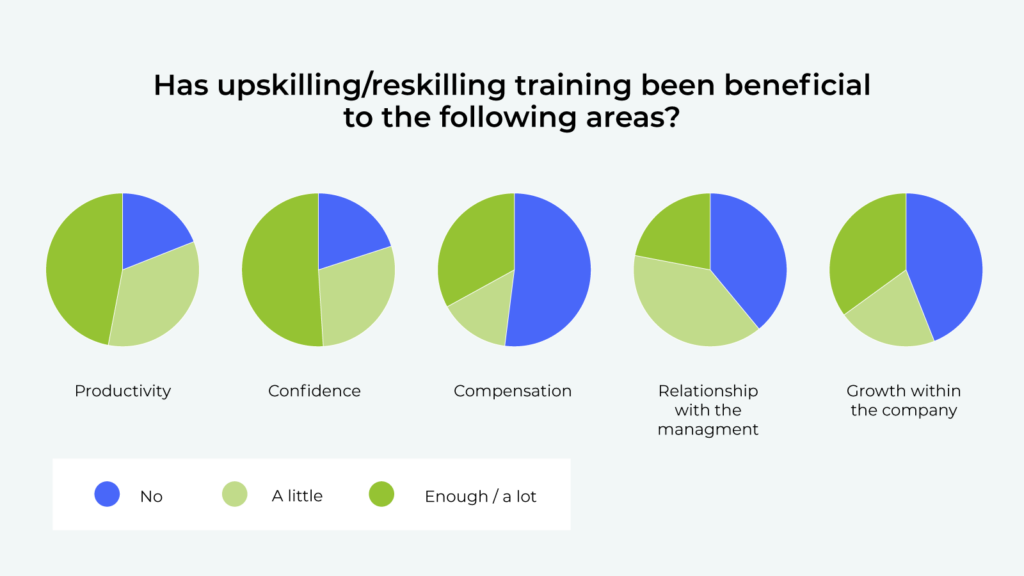The rise of employee upskilling in the workforce

Technological shifts and changing market dynamics consistently redefine industries and job roles. Consequently, skills once deemed essential may now be outdated. Recognizing this, many organizations emphasize the importance of continuous employee upskilling.
Upskilling isn’t merely about updating technical expertise but also enhancing adaptability and prepping teams for upcoming challenges.
This focus on growth underscores an organization’s commitment to its workforce’s development, fostering a culture of perpetual learning. Upskilled employees often exhibit increased engagement and loyalty, envisioning growth alongside their organization.

Additionally, they drive innovation and efficiency, staying ahead of market changes and leveraging new technologies.
Organizations championing upskilling also gain a competitive hiring advantage, attracting ambitious talent while reducing external hiring costs. In summary, as work dynamics evolve rapidly, upskilling serves as a crucial bridge, ensuring organizations and their teams remain relevant and ahead in a swiftly changing professional realm.
The modern workforce
The evolution of jobs over time, from manufacturing in the industrial age to today’s tech-driven roles, highlights the fluidity of the professional landscape. As job profiles evolve, so do the essential skills, emphasizing the importance of upskilling for both organizations and their employees.
Upskilling, defined as the enhancement of current skills, is a vital adaptation to the dynamic job market. With the rapid onset of new technologies and shifting industry trends, once-prized skills can soon become outdated. In such a setting, continuous learning isn’t just beneficial; it’s imperative.
For companies, upskilling initiatives represent an investment in their workforce’s adaptability and growth. It signals that while specific tools may change, the significance of a versatile employee endures. Through training and continuous learning opportunities, organizations ensure their teams remain adept and future-ready.

For workers, upskilling offers a path to career progression and stability. In a world where automation and AI transform roles, the ability to learn and adjust becomes paramount. This not only elevates their contribution within their current firms but also enhances their marketability externally.
Furthermore, promoting upskilling cultivates a culture of ongoing learning. With a shared focus on skill enhancement, workplaces experience mutual growth, fostering innovation and collaboration.
The demand for skills
The evolving nature of jobs
The evolution of jobs over time, from manufacturing in the industrial age to today’s tech-driven roles, highlights the fluidity of the professional landscape.
As job profiles evolve, so do the essential skills, emphasizing the importance of upskilling for both organizations and their employees.
Upskilling, defined as the enhancement of current skills, is a vital adaptation to the dynamic job market. With the rapid onset of new technologies and shifting industry trends, once-prized skills can soon become outdated. In such a setting, continuous learning isn’t just beneficial; it’s imperative.
For companies, upskilling initiatives represent an investment in their workforce’s adaptability and growth. It signals that while specific tools may change, the significance of a versatile employee endures. Through training and continuous learning opportunities, organizations ensure their teams remain adept and future-ready.
For workers, upskilling offers a path to career progression and stability. In a world where automation and AI transform roles, the ability to learn and adjust becomes paramount. This not only elevates their contribution within their current firms but also enhances their marketability externally.
Furthermore, promoting upskilling cultivates a culture of ongoing learning. With a shared focus on skill enhancement, workplaces experience mutual growth, fostering innovation and collaboration.
In summary, while jobs have transformed over time, the need for adaptability persists. Upskilling stands as a guiding light, ensuring both individuals and businesses stay ahead in an ever-changing professional realm.
A few decades back, jobs were largely manual and skill-specific. Today, we’re amidst a dynamic job market that demands a blend of soft and technical skills.

With technology’s ascent, roles like ‘data scientist’ have emerged, which were previously inconceivable.
This swift shift underscores the importance of skill gap analysis. Essentially, this is a method to determine the difference between employees’ existing skills and those needed for their roles. In today’s fluid job market, identifying these gaps is vital.
Organizations leveraging skill gap analysis can adeptly traverse the modern job landscape. By identifying skill deficiencies, they can craft precise training and upskilling programs. For instance, offering courses on new digital tools for upcoming social media teams or advanced data sessions for analysts ensures targeted learning.
For employees, understanding their skill positioning vis-� -vis market needs offers a developmental blueprint, spotlighting areas for growth to stay competitive.
Additionally, skill gap analysis aids in strategic recruitment. Knowing the in-house skills versus required expertise facilitates informed hiring decisions, ensuring new employees fill the identified voids.
In summary, the shift from simplistic jobs to today’s multifaceted roles brings challenges. Skill gap analysis serves as a guiding beacon, helping both organizations and employees stay equipped and future-ready.
The role of technology in skill demand
Technology presents both opportunities and challenges. While it has ushered in a range of novel professions, it has also rendered some roles redundant. This swift technological evolution has resulted in a disparity between the demand for specific skills and their availability, underscoring the imperative for upskilling.

Benefits of employee upskilling
Ever wondered why companies are so keen on upskilling their employees?
Boosting employee morale and engagement
When employees discern that their company is genuinely committed to their developmental journey, it fosters a profound sense of appreciation and belonging.
This investment in personal and professional growth goes beyond merely imparting new leadership skills; it resonates on a deeper, more emotional level.
Upskilling initiatives serve as tangible evidence of a company’s faith in its workforce. By providing opportunities for skill enhancement, organizations are not just preparing their teams for future challenges, but also instilling in them a renewed sense of purpose and self-worth.
Such endeavors often lead to heightened confidence, as employees feel better equipped to handle their roles and contribute meaningfully to the organization’s objectives.
Furthermore, the psychological impact of upskilling is noteworthy. When employees perceive that they are regarded as valuable assets, their morale receives a significant boost.
This positivity translates into increased enthusiasm, dedication, and overall engagement with their tasks.
A content and motivated employee invariably becomes a proactive and productive member of the team, bringing forth innovative ideas, displaying collaborative spirit, and driving the organization’s success.
Increasing organizational productivity and profitability
By upskilling employees, companies can fill skill gaps internally rather than hiring externally. This not only saves on recruitment costs but also increases productivity. After all, a well-trained employee can take on more complex tasks, right?
The challenges in implementing employee upskilling programs
Upskilling isn’t a walk in the park. It comes with its set of challenges.
Identifying relevant skills
With the plethora of skills out there, how do companies decide which ones to focus on? It’s like being a kid in a candy store but not knowing which candy to pick!
Ensuring continual learning
Upskilling isn’t a one-time activity. With the ever-changing business landscape, continuous learning is the need of the hour.
Best practices for employee upskilling
Thinking of starting an upskilling training program now? Here are some tips to get you started.
Aligning with business goals
Upskilling should align with the company’s strategic goals. It’s not just about adding skills but adding the right skills.
Leveraging technology for training
Online courses, virtual reality, and AI-driven platforms are revolutionizing the way we learn. Companies can leverage these technologies to provide flexible and effective training.
Real-world examples of successful employee upskilling
Degreed journey with employee upskilling
Workers are becoming increasingly cognizant of the evolving demands of the current job and market. With the realization that their existing skill sets may not be sufficient for the future, there’s a growing eagerness among employees to bridge their skills gaps to remain pertinent in their professions.
As Kelly Palmer from Degreed and Aaron Hurst, the CEO of Imperative, note, a vast number of employees are keen on expanding their skill sets while on the job.
Yet, there’s a noticeable lag when it comes to corporate investments in learning and enhancement programs tailored for employees.
Deloitte’s 2020 Global Human Capital Trends Report offers a telling statistic: a mere 17% of the surveyed organizations have made substantial investments in initiatives focused on AI-specific skill development. Such underinvestment poses risks, potentially sidelining both employees and their organizations from future opportunities and advancements.
In the current competitive landscape, prioritizing the training of existing staff to bridge skill deficiencies is not just beneficial but crucial for an organization’s sustained growth and relevance.
As highlighted by Carol Patton at Human Resource Executive, upskilling or reskilling initiatives have evolved from being mere trends to becoming essential strategies that propel and uphold a company’s expansion.
However, several challenges deter companies from wholeheartedly embracing reskilling and upskilling programs. Siddhartha Gupta, the CEO of Mercer Mettl, points out some of these hurdles, which include:
- Pinpointing the precise skills that need enhancement.
- Allocating dedicated time slots for employee training sessions.
- Setting aside sufficient funds for comprehensive learning and development initiatives.
Nevertheless, with a well-structured strategy, organizations, regardless of their size, can successfully implement and benefit from reskilling and upskilling programs. Several trailblazing organizations offer valuable insights into how to effectively roll out such initiatives, providing lessons and blueprints for others to emulate.
How Orange embraced the upskilling wave
Overview
Orange, a frontrunner in the telecommunications sector, embarked on a transformative journey with DevSkiller. Their mutual endeavor?
To ensure that Orange’s workforce was primed and ready for the future challenges and shifts within the company’s evolving digital strategy.
Objectives
- Skill Maximization: Equip employees with the requisite skills, ensuring they reach their maximum potential.
- Boosting Job Satisfaction: A keen focus on enhancing employee contentment and, consequently, retaining them for longer.
- Alignment with Vision: Syncing individual employee growth trajectories with overarching company goals.
“Here at Orange, our initiative is central to our human capital strategy. Through meticulous planning in the skills management process, we aim to leverage high-quality data. This ensures our training and internal mobility programs resonate with our business goals.”

Challenges Faced
- Innovative Transition: Orange’s journey entailed pivoting from traditional telecom services to embrace avant-garde technologies such as 5G and IoT. All this while ensuring they remained a potent force in a rapidly evolving market landscape.
- Skill Alignment: One significant hurdle was ensuring that the skills of the employees were in sync with the company’s digital aspirations, making them adept at catering to the dynamic demands of the telecom industry.
- Employee Satisfaction: Orange was keen on amplifying employee contentment. Their strategy? Provide incisive assessments, holistic onboarding experiences, and avenues for self-assessment and career progression.
- Addressing Skill Gaps: It was imperative for Orange to pinpoint skill deficiencies within their ranks and address them, ensuring their workforce was future-ready.
- Managerial Support: Ensuring managers had the requisite tools and backing to execute the digital talent strategy, thus fueling business expansion, was pivotal.
“When we initiated DevSkiller Upskilling platform, our plan was to roll it out for 200 of our employees. The response was overwhelming, leading us to expand the pilot program by a staggering 4 times.” – Anna Got, Culture Change Manager, Orange.
Solution Deployed
Orange ushered in DevSkiller, a robust skills management platform. The aim? Seamlessly meld training and internal mobility schemes with business aspirations. DevSkiller offered a plethora of features, from skill development to market benchmarks, ensuring Orange had a pulse on skill trends. The initiative, ‘SkillsUp’, powered by DevSkiller, was instrumental in identifying and bridging skill gaps, ensuring every employee was equipped to excel.
Outcomes
- Employee Engagement: A whopping 98% completion rate for onboarding sessions, indicative of high employee enthusiasm and allegiance.
- Visibility and Future Planning: An impressive 95% of employees mapped out their skill trajectories, paving the way for enhanced future planning.
- Career Development Engagement: Employees showcased their commitment to self-growth, with an average self-assessment time of 21 minutes.
By harnessing the prowess of DevSkiller, Orange not only ensured they were future-ready but also fostered an environment where employees felt valued, skilled, and aligned with the company’s vision.
The future of employee upskilling
The upskilling wave is here to stay. With the ongoing technological advancements and the evolving nature of jobs, the demand for new skills will only grow. Companies that embrace the benefits of upskilling will not only thrive but also lead the way.
Conclusion
Investing in employee upskilling is no longer a luxury but a necessity. By equipping employees with the skills they need, companies can ensure their long-term success. So, are you ready to invest in your employees’ potential?
Discover how DevSkiller upskilling tool can help you.
Schedule a demo with one of our product experts or watch this quick 5-min demo video to find out more.
FAQs
- What is employee upskilling?
Upskilling refers to the process of teaching employees new or advanced skills.
- Why is upskilling important?
It helps bridge the skills gap, boosts employee engagement and morale, and increases organizational productivity.
- How do companies identify which skills to focus on?
By aligning upskilling with business goals and regularly assessing skill needs.
- Can small businesses implement upskilling?
Absolutely! There are numerous online platforms that offer affordable training programs.
- Is upskilling a one-time activity?
No, it’s an ongoing process due to the ever-changing nature of the business landscape.
Share post